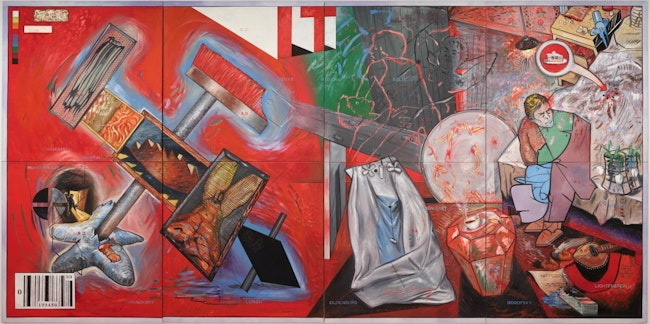The art that made me: Abdul Abdullah
In The art that made me, artists discuss works in the Art Gallery of New South Wales collection that either inspire, influence or simply delight them.

Abdul Abdullah, photo: Isabella Melody Moore
Abdul Abdullah, photo: Isabella Melody Moore
Often playful, with an ironic wit, the art of Abdul Abdullah questions many social attitudes with a cutting depth of feeling below the polished surface. Born in Perth and based in Sydney, the multiple-time finalist of the Archibald, Wynne and Sulman Prizes explores the emotions and anxieties caused by isolation through his new paintings for The National 4: Australian Art Now. Uncertainty, confusion, sadness and pure joy animate the faces of his ‘anthropomorphised rocks’ as boldly simple white ‘smileys’ against his intricately painted landscapes. Evolving from our experiences of the global pandemic, the works depict ‘stress, joy, or self-reflection that while experienced in moments of isolation, are broadly relatable, and can be understood and engaged with as shared, communal experiences,’ Abdullah tells Look, the Art Gallery members magazine. ‘Each rock greets or reflects on someone or something that they are reacquainting themselves with after a period of departure. I like to imagine the rocks have existed for a very long time, and we are only just discovering them ... they have been waiting for us and are pleased to see us.’ Here Abdullah shares four artists and works that have shaped him.
Richard Bell We can be heroes 2014

Richard Bell We can be heroes 2014, Art Gallery of New South Wales © Richard Bell & Emory Douglas, courtesy Milani Gallery, Brisbane
For me Richard is a friend, a mentor and was a subject for me in the 2014 Archibald Prize. I first met him in 2012 in his kitchen in Brisbane with Vernon Ah Kee and Gordon Hookey. I was in awe of the three of them, and when I asked how does an artist make money between shows, Richard chastised me and said ‘by making f****** good art’. I introduced him to Tada Hengsapkul, an artist from Thailand in Brisbane for the ninth Asia Pacific Triennial, and Tada asked if he was like the godfather of Australian art, and I said ‘yes’.
Hugh Ramsay Two girls in white 1904

Hugh Ramsay Two girls in white 1904, Art Gallery of New South Wales
I love the way Hugh Ramsay paints and Two girls in white is me and my Aunty Terri’s favourite painting in the Grand Courts galleries. As someone who paints a lot I am fascinated by Ramsay’s application of paint. The dresses and the shag rug are wild. When I look at it, I imagine tracing Ramsay’s marks with an invisible brush. Each one seems so loose but is at the same time so deliberate.
Juan Davila Neo-Pop 1983–85

Juan Davila Neo-Pop 1983–85, Art Gallery of New South Wales © Juan Davila, courtesy Kalli Rolfe Contemporary Art
Juan Davila is an artist that has occupied that part of my brain labelled ‘what art can be’ since I was a little boy. My mother sewed a lot when I was young, and I would accompany her to Lincraft in the city each time she would go. We would catch the train to Perth and right above the station was the Art Gallery of Western Australia, and we would always pop in. My mother loved the paintings of landscapes, and I would always be drawn to the giant Juan Davila. Even as a kid it opened up possibilities of what art could be.
Tracey Moffatt Love 2003

Tracey Moffatt Love 2003, Art Gallery of New South Wales © Tracey Moffatt, courtesy of Roslyn Oxley9 Gallery, Sydney
I studied Tracey when I was in school, and really liked her work, but it was in 2011 when I saw her work Other at the Singapore Biennale where I fell in love. Like Other, Love is from her series of supercuts featuring edits (by Gary Hillberg) from film and television that speak to a theme. They use humour, drama and juxtaposition to recontextualise images into a new and exciting narrative. The conceptual approach to this series has had a lasting impact on how I make work.
A version of this article first appeared in Look – the Gallery’s members magazine